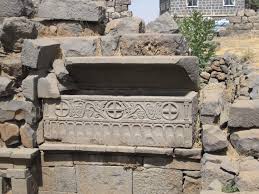The mountainous village of Qanawt is located about 80 km south of Damascus and 7km north east of Al-Sweida governorate. The archeological village which is about 1240m over the sea level was constructed on one of the city’s most beautiful mountain and in front of it there is a deep valley.
Kanath: it is an ancient name of Qanawat. The name of Kanatha means the city of canals. the ancient water canals in Qanawat form a complete water net and it is still preserved until now.
The historical village of Qanawat is inhabited since the old days and it was mentioned by the ancient writers as one of the ten cities which Were located at the eastern part of the Jordan River and named by the’ ‘allied cities”.
The village which played an important role in the commercial field due to its location as a connection point between Bosra and Damascus was rearranged and reconstructed at the period of the ruler Pompuls in cooperation with the leader Gapinus.
The 1st century witnessed the village’s development at the economical field.
 The important archeological buildings in the village of Qanawat are related to the Roman and Byzantine periods.
The important archeological buildings in the village of Qanawat are related to the Roman and Byzantine periods.
The buildings form a mixture between Syrian, Greek and Byzantine cultures. Kanatha at that time was considered as the center of the episcopacy.
The ancient village of Qanawat continued to grow until the 1st Islamic period. The village was re inhabited in the eighteen century.
From the most distinguished ruins in Qanawat are
The archeological theater:
-The half circular theater has more than one auditorium it is also surrounded by a temple and a special water canal which was build with engraved stones. The theater was build on the bank of Qanawat’s famous valley. It was allocated for performing the temple’s religious ritual.
 The stones of the theater are still carrying Greek statements on the benefactor who paid for constructing the theater.
The stones of the theater are still carrying Greek statements on the benefactor who paid for constructing the theater.
– the western gate of the ancient city is also considered from Qanawat most distinguished ruins .
– the temple of the Goddees Zioyos Majestors which is located in the southern side of the old city and related to the 2nd century AD is also still standing in the archeological city.
The temple’s entrance is surrounded by six columns with decorated crowns.
– the temple of the Goddess Helios (Rabious) is also located in the village And it was devoted for worshiping the god of sun. It also has 31 columns with decorated crowns.
The columns are still standing on a stone base which form ceiling for a stone roam.
The Helios temple’s date is related to 1st century BC.
Nahla Maaz – for syriatimes – Sweida governorate

